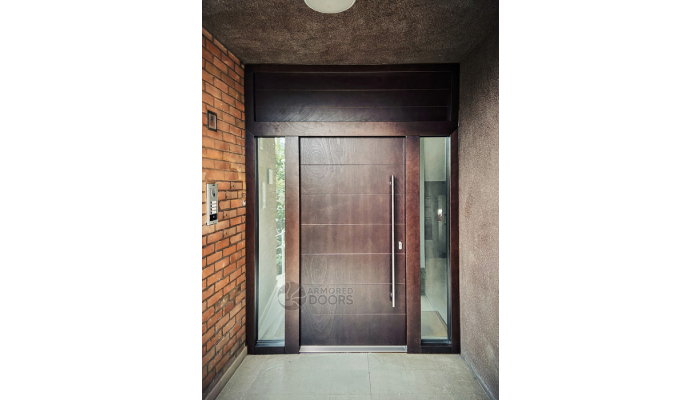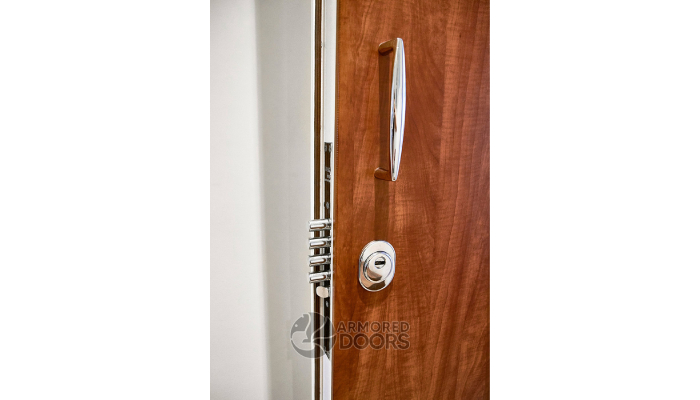
When comparing steel security doors to wooden doors, several key factors come into play. Steel doors are renowned for their durability and longevity. Made from premium-grade steel, they resist dents and environmental changes, lasting decades with minimal maintenance. On the other hand, wooden doors can warp or swell when exposed to moisture and demand consistent upkeep. Security is another critical aspect; steel doors provide formidable barriers with advanced locking systems, while wooden alternatives often lack similar strength against forced entry. Additionally, steel doors offer better fire resistance and energy efficiency compared to their wooden counterparts. Though both have aesthetic appeal, particularly wood’s natural charm, opting for steel generally leads to enhanced protection and lower costs over time.
1. Durability and Longevity of Steel vs Wooden Doors
Steel security doors outshine wooden doors when it comes to durability and longevity. Made from high-quality steel, these doors resist dents and scratches much better than wood, which can show wear and tear fairly quickly. Steel doors are designed to withstand extreme weather without significant damage, ensuring they maintain their integrity over time. In contrast, wooden doors can crack or splinter, especially when exposed to harsh elements like heavy rain or intense sunlight.
Another advantage of steel doors is their protective finish, which helps prevent rust and corrosion, further extending their lifespan. While wooden doors may need replacement after a couple of decades, steel doors can last for decades with minimal maintenance. The consistent manufacturing process of steel doors guarantees their strength and durability, while wooden doors are susceptible to warping and bending, compromising both their shape and function over time.
Additionally, wooden doors may require frequent upkeep, such as sealing and painting, to protect against moisture and pests, which can lead to structural issues. In contrast, steel doors require less frequent maintenance and are less affected by environmental conditions, which can lead to lower long-term costs. Thus, investing in steel doors not only enhances security but also proves to be a more economical choice in the long run.

2. Security Features of Steel Security Doors
Steel security doors are specifically designed with security in mind, offering numerous advantages over traditional wooden doors. One key feature is the multi-point locking system, which secures the door at multiple locations, making it significantly harder for intruders to force their way in. Additionally, steel doors typically have a thicker gauge than standard wooden options, providing an extra layer of resistance against break-ins.
Many steel doors also come equipped with advanced features like peepholes and integrated security cameras, allowing homeowners to monitor activity at their door. These doors undergo rigorous testing against forced entry, ensuring they meet high safety standards. The steel is often powder-coated, which not only enhances durability but also adds protection against tampering.
In contrast, wooden doors can easily be compromised with basic tools like crowbars, making them a less secure option. Steel doors often include reinforced hinges, which help resist tampering, further increasing their security profile. Customization options for steel doors allow homeowners to incorporate sophisticated security features tailored to their specific needs. Some even offer impact-resistant glass, providing an additional barrier against significant force. For homeowners, especially those in higher crime areas, steel doors deliver peace of mind, knowing they have a robust defense against potential break-ins.
3. Fire Resistance Comparison
When it comes to fire resistance, steel security doors outshine wooden doors. Steel doors are rated for fire resistance and can withstand flames for anywhere from 20 minutes to several hours, depending on the model. Their non-combustible nature means they won’t ignite easily, serving as a solid barrier to prevent the spread of fire. This is particularly crucial in commercial properties, where regulations often mandate the installation of steel doors for safety.
In contrast, wooden doors, while they can be treated with fire-resistant chemicals, are still more likely to catch fire and contribute to the spread of flames. Although treatments can improve their fire resistance, they simply do not match the inherent safety features of steel. After exposure to fire, wooden doors may need replacement sooner, while steel doors can often be salvaged, providing a longer-term safety solution.
Fire-rated steel doors are rigorously tested to ensure they work effectively in emergencies, offering peace of mind for homeowners and businesses alike. Many insurance companies even provide discounts for properties equipped with these doors, recognizing their safety benefits. Ultimately, steel doors add a crucial layer of protection during a fire, safeguarding both lives and property.
4. Energy Efficiency of Steel and Wooden Doors
When considering energy efficiency, steel security doors often have the upper hand. They can be filled with insulation materials that significantly reduce heat transfer, helping to keep indoor temperatures stable. This insulation not only contributes to a comfortable living environment but can also lead to lower energy bills, especially in colder climates where heating costs can be drastically reduced. Steel doors may also come with Energy Star ratings, further indicating their efficiency in heating and cooling homes.
In contrast, wooden doors do have natural insulating properties, but their effectiveness can diminish over time. As wood ages, it may warp or develop gaps, which allows air leaks and drafts to penetrate the home, compromising insulation. Regular maintenance is essential for wooden doors to ensure they remain energy efficient, as neglect can lead to increased energy costs.
Steel doors are designed with weather stripping that minimizes drafts, enhancing their overall energy performance. With the thermal mass of steel, these doors can help stabilize indoor temperatures, further promoting energy efficiency. Overall, choosing the right door can have a significant impact on energy savings over time.
5. Aesthetic Appeal of Steel and Wooden Doors
Steel security doors have come a long way in terms of design. Nowadays, they are available in an array of styles and colors, even mimicking the look of wood while retaining their durability. This means homeowners can enjoy the benefits of a strong door without sacrificing aesthetic appeal. Many steel doors can be customized with decorative glass, intricate patterns, and various finishes, enhancing their visual charm. On the other hand, wooden doors exude a natural, warm appearance that resonates with homeowners who appreciate traditional aesthetics. Their unique grains and textures can bring a touch of elegance to any entrance.
Moreover, wooden doors can be carved or designed in unique styles, allowing for a personalized touch that reflects individual tastes. While wooden doors can be painted or stained to match a home’s design, they require regular maintenance to keep them looking fresh, as fading can occur over time. In contrast, steel doors are designed to resist fading, maintaining their pristine appearance for longer periods. Steel doors also complement modern architectural designs beautifully, while wooden doors typically fit better in classic or rustic settings. Ultimately, the choice between steel and wooden doors often boils down to personal preference and the existing style of the home. For those looking to integrate smart home technology, steel doors can easily accommodate modern features, while wooden doors offer a timeless charm that can enhance curb appeal and potentially increase property value.
6. Cost Considerations for Steel and Wooden Options
When comparing steel security doors and wooden doors, cost is a significant factor. Steel doors often have a lower long-term cost, primarily due to their durability and reduced maintenance needs. While the initial purchase price of a high-quality wooden door can be higher, particularly for solid wood options, the ongoing costs may add up. Wooden doors require periodic refinishing to maintain their appearance and resist environmental damage, which can become a financial burden over time.
On the other hand, steel doors frequently come with warranties that cover manufacturing defects, enhancing their value and providing peace of mind. Although the upfront cost of steel doors might seem steep, their lifespan can lead to better long-term investment returns when factoring in replacement and upkeep costs. In high-traffic areas, steel doors prove more cost-effective due to their resistance to damage, further justifying the investment.
Installation costs can also vary; steel doors, being heavier, often necessitate professional installation, which can add to the overall expense. Wooden doors, however, may be more manageable for DIY projects, potentially saving on installation costs. Additionally, the choice of door can influence a home’s resale value, with steel doors often viewed as an attractive selling point due to their security features and durability. In summary, evaluating both initial and long-term costs is essential when considering which option may be right for you.
7. Overall Recommendation for Door Selection
When deciding between steel security doors and wooden doors, several factors come into play. For homeowners who prioritize security, steel doors stand out as the clear choice due to their robust construction and advanced protective features. They are particularly beneficial in high-risk areas, where their strength can deter break-ins and provide invaluable peace of mind. On the other hand, if aesthetics take precedence, wooden doors may appeal more with their natural beauty and charm. However, keep in mind that they require more maintenance and are less durable in challenging weather conditions.
In moderate-risk areas, wooden doors can still offer reasonable security while enhancing the visual appeal of your home. It’s essential to weigh long-term costs against immediate needs. Steel doors might have a higher upfront cost but can save money over time with their durability and energy efficiency. Energy efficiency is another consideration; steel doors typically outperform wooden options, leading to lower heating and cooling costs.
Additionally, the style of your home should play a role in your decision. A door should complement the overall aesthetic of your property. Consulting with professionals can help clarify your options based on your specific situation. Ultimately, the best choice hinges on a balance of aesthetics, security, durability, and cost.